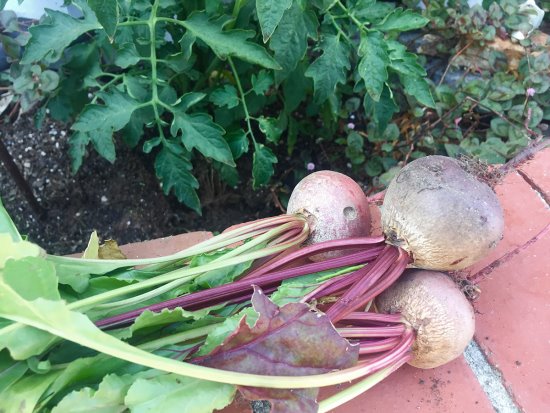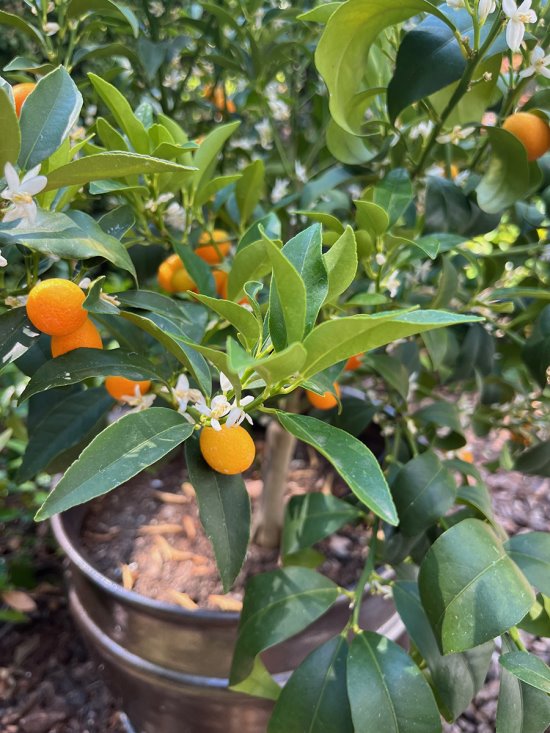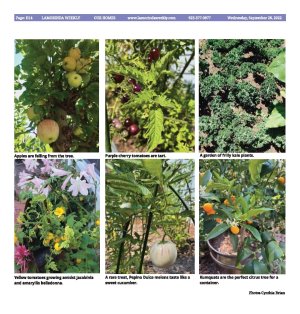|
|
Published September 28th, 2022
|
Digging Deep with Goddess Gardener, Cynthia Brian
|
| Fall forward |
| By Cynthia Brian |
 |
| An abundance of nutritious fresh vegetables. Photo Cynthia Brian |
"Delicious Autumn! My soul is wedded to it, and if I were a bird, I would fly about the earth seeking the successive Autumns." ~ George Eliot
 The sweet smell of the recent rain-dampened soil stimulated my soul. Although it wasn't enough moisture to revive a parched earth, my brown lawn exhibits more strands of green. This short respite from the horrendous heat of the first part of September was a welcome beacon of the cooler forthcoming autumn.
The sweet smell of the recent rain-dampened soil stimulated my soul. Although it wasn't enough moisture to revive a parched earth, my brown lawn exhibits more strands of green. This short respite from the horrendous heat of the first part of September was a welcome beacon of the cooler forthcoming autumn.
 This surprise rainfall was also an indication that it is time to complete harvesting our summer crops before the rainy season begins. Nature has a way of informing us about the optimum time to pluck our favorite vegetable or fruit at its peak of flavor. Berries are plump, juicy, and deep in color. Apples fall into our hands the second they are touched. Our noses lead us to the sweet smell of ripe Asian pears, our eyes shine when we see that perfect deep red tomato, and our ears listen for the hollow thump of a crunchy melon. We use our senses to identify the best time to harvest, including our common sense.
This surprise rainfall was also an indication that it is time to complete harvesting our summer crops before the rainy season begins. Nature has a way of informing us about the optimum time to pluck our favorite vegetable or fruit at its peak of flavor. Berries are plump, juicy, and deep in color. Apples fall into our hands the second they are touched. Our noses lead us to the sweet smell of ripe Asian pears, our eyes shine when we see that perfect deep red tomato, and our ears listen for the hollow thump of a crunchy melon. We use our senses to identify the best time to harvest, including our common sense.
 In my garden, because of the heatwave we experienced, many of my fruits are self-harvesting including apples, pears and citrus. (Self-harvesting means that when the fruit is ripe, it automatically falls from the tree.) The challenge with self-harvesting is that the fruit bruises or gets dirt, rocks, or sticks stuck in its flesh. Cut out the blemishes, wash, and eat the rest!
In my garden, because of the heatwave we experienced, many of my fruits are self-harvesting including apples, pears and citrus. (Self-harvesting means that when the fruit is ripe, it automatically falls from the tree.) The challenge with self-harvesting is that the fruit bruises or gets dirt, rocks, or sticks stuck in its flesh. Cut out the blemishes, wash, and eat the rest!
 To move forward with fall harvesting, pick your produce early in the morning, just as the sun is rising. The air is cooler, and the crops are crisp, allowing them to last longer. If you wait to pick until the heat of the day, lettuces, radishes, peas, chards, and leafy greens will be limp and wilted. The second-best time to harvest your non-droopy crops like zucchini, grapes, tomatoes, and root vegetables is early evening, preferably after the sun has set. The early sunbathing adds to their sugariness.
To move forward with fall harvesting, pick your produce early in the morning, just as the sun is rising. The air is cooler, and the crops are crisp, allowing them to last longer. If you wait to pick until the heat of the day, lettuces, radishes, peas, chards, and leafy greens will be limp and wilted. The second-best time to harvest your non-droopy crops like zucchini, grapes, tomatoes, and root vegetables is early evening, preferably after the sun has set. The early sunbathing adds to their sugariness.
 Harvesting Hints to help you pick, pull, and pluck a sampling of your garden favorites at the peak of perfection.
Harvesting Hints to help you pick, pull, and pluck a sampling of your garden favorites at the peak of perfection.
 Apples: When you touch a ripe apple, regardless of variety, it should need only a slight pull to fall off the branch.
Apples: When you touch a ripe apple, regardless of variety, it should need only a slight pull to fall off the branch.
 Beans: Pick before the pods begin to swell and when the strings are still slender. Pick often to encourage more bean development.
Beans: Pick before the pods begin to swell and when the strings are still slender. Pick often to encourage more bean development.
 Beets: Pull when beets are 1 1/2 inch to 2 inches in diameter. Cut off the tops to use in cooking or chop them into salads.
Beets: Pull when beets are 1 1/2 inch to 2 inches in diameter. Cut off the tops to use in cooking or chop them into salads.
 Carrots: Whether you are growing orange, purple, yellow, or white carrots, loosen the soil when they are
1/2-1 inch thick, then pull.
Carrots: Whether you are growing orange, purple, yellow, or white carrots, loosen the soil when they are
1/2-1 inch thick, then pull.
 Cucumbers: Harvest cucumbers when they are shiny and small. The bigger they get, the more bitter and seedy they become. Lemon cucumbers will be slightly yellow while English and Armenian cucumbers will be green. Frequent picking encourages more growth.
Cucumbers: Harvest cucumbers when they are shiny and small. The bigger they get, the more bitter and seedy they become. Lemon cucumbers will be slightly yellow while English and Armenian cucumbers will be green. Frequent picking encourages more growth.
 Pepino Dulce Melons: When you see the pink stripe and the fruit is about 2 inches in diameter, these sweet cucumber/melons are ready to eat.
Pepino Dulce Melons: When you see the pink stripe and the fruit is about 2 inches in diameter, these sweet cucumber/melons are ready to eat.
 Eggplants: Young eggplants are the tastiest and sweetest. Their flesh is glossy purple. Do not pull eggplants. Cut with a sharp knife.
Eggplants: Young eggplants are the tastiest and sweetest. Their flesh is glossy purple. Do not pull eggplants. Cut with a sharp knife.
 Fennel: Cut bulbing fennel at the soil line. Use the bulb as well as the ferny leaves in recipes. If your fennel has yellow flowers, save the seeds for your culinary recipes.
Fennel: Cut bulbing fennel at the soil line. Use the bulb as well as the ferny leaves in recipes. If your fennel has yellow flowers, save the seeds for your culinary recipes.
 Grapes: If you are growing grapes, you know when they are ready to be harvested by doing a taste test. Don't pull the bunch from the vine. Use a sharp knife to cut individual bunches.
Grapes: If you are growing grapes, you know when they are ready to be harvested by doing a taste test. Don't pull the bunch from the vine. Use a sharp knife to cut individual bunches.
 Kale: Leave six to eight leaves of the kale on the stem when picking kale. Kale grows quickly and will continue to send out more leaves.
Kale: Leave six to eight leaves of the kale on the stem when picking kale. Kale grows quickly and will continue to send out more leaves.
 Peppers: For the ultimate in flavor and sweetness, allow peppers to grow to their deepest colors of green, red, yellow, orange, and purple. Twist and pick whatever size you wish.
Peppers: For the ultimate in flavor and sweetness, allow peppers to grow to their deepest colors of green, red, yellow, orange, and purple. Twist and pick whatever size you wish.
 Pumpkins: Try to pierce the skin of a pumpkin with your fingernail to determine ripeness. Cut the stem at least 3 inches long and let the pumpkin cure for a week or more in the sun. Pumpkins will last a very long time when stored at 48-50 degrees in a dry environment.
Pumpkins: Try to pierce the skin of a pumpkin with your fingernail to determine ripeness. Cut the stem at least 3 inches long and let the pumpkin cure for a week or more in the sun. Pumpkins will last a very long time when stored at 48-50 degrees in a dry environment.
 Tomatoes: For the richest flavor, be patient and wait for your tomato to reach its full sun-ripened color for the specific variety. When rain threatens, pick your green tomatoes, and leave them on the counter. Most will ripen at room temperature. Whatever you do, never refrigerate tomatoes after picking or you'll lose nutrients and flavor.
Tomatoes: For the richest flavor, be patient and wait for your tomato to reach its full sun-ripened color for the specific variety. When rain threatens, pick your green tomatoes, and leave them on the counter. Most will ripen at room temperature. Whatever you do, never refrigerate tomatoes after picking or you'll lose nutrients and flavor.
 Leafy greens: Nutritious leafy greens like arugula, lettuce, Swiss chard, and spinach continue to sprout. Harvest as needed to augment and accent your other edibles. The smaller the greens, the more concentrated the vitamins and minerals.
Leafy greens: Nutritious leafy greens like arugula, lettuce, Swiss chard, and spinach continue to sprout. Harvest as needed to augment and accent your other edibles. The smaller the greens, the more concentrated the vitamins and minerals.
 Keep in mind that the birds, squirrels, skunks, raccoons, deer, rabbits, and other critters are as excited about the fall harvest as you are. They may start their feeding frenzy before your yields are at their optimum ripeness. Be vigilant and if necessary, gather your bounty earlier than expected.
Keep in mind that the birds, squirrels, skunks, raccoons, deer, rabbits, and other critters are as excited about the fall harvest as you are. They may start their feeding frenzy before your yields are at their optimum ripeness. Be vigilant and if necessary, gather your bounty earlier than expected.
 The end of crop harvesting heralds the beginning of autumn as a time for rejoicing. When I was a kid growing up on our farm, a barn dance signaled the finality of the harvest and time to rest from a season of working in the fields. In our communities, we celebrate with festivals and fairs that are filled with family fun. Fall is a delightfully delicious time of year with the abundance of farm-fresh fruits and vegetables ripe and ready. Pick, eat, enjoy!
The end of crop harvesting heralds the beginning of autumn as a time for rejoicing. When I was a kid growing up on our farm, a barn dance signaled the finality of the harvest and time to rest from a season of working in the fields. In our communities, we celebrate with festivals and fairs that are filled with family fun. Fall is a delightfully delicious time of year with the abundance of farm-fresh fruits and vegetables ripe and ready. Pick, eat, enjoy!
 Happy Gardening and Happy Growing!
Happy Gardening and Happy Growing! |
 |
| Japanese eggplant, zucchini, lettuce, and more are harvested.Photo Cynthia Brian |
 |
| Harvested beets with tomato vine in the rear. Photo Cynthia Brian |
 |
| Fennel blossoms and seeds are excellent for seasoning. Photo Cynthia Brian |
 |
| Apples are falling from the tree. Photo Cynthia Brian |
 |
| Purple cherry tomatoes are tart. |
 |
| A garden of frilly kale plants. |
 |
| Yellow tomatoes growing amidst jacobinia and amaryllis belladonna. |
 |
| A rare treat, Pepino Dulce melons taste like a sweet cucumber. |
 |
| Kumquats are the perfect citrus tree for a container. |
 |
| Cynthia Brian by a fall fountain |
| |
Cynthia Brian, The Goddess Gardener, is available for hire to help you prepare for your fall garden. Raised in the vineyards of Napa County, Cynthia is a New York Times best-selling author, actor, radio personality, speaker, media and writing coach as well as the Founder and Executive Director of Be the Star You Are!r 501 c3. Tune into Cynthia's StarStyler Radio Broadcast at
www.StarStyleRadio.com. Her newest children's picture book series, "Stella Bella's Barnyard Adventures," will be available soon. Buy copies of her books,
www.cynthiabrian.com/online-store. Receive a FREE inspirational music DVD and special savings. For an invitation to hang out with Cynthia for fun virtual events, activities, conversations, and special perks, buy a StarStyler NFT at
https://StarStyleCommunity.com Hire Cynthia for writing projects, garden consults, and inspirational lectures.
Cynthia@GoddessGardener.com
www.GoddesGardener.com
|
|
|
|















